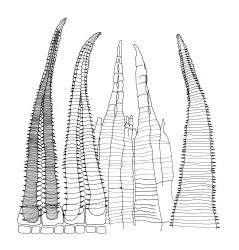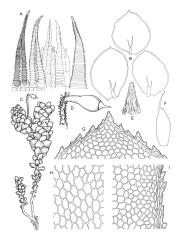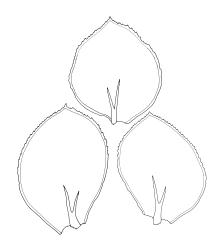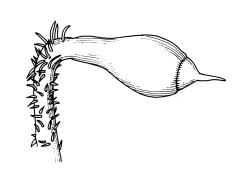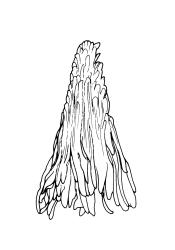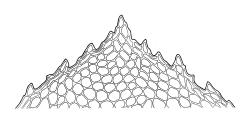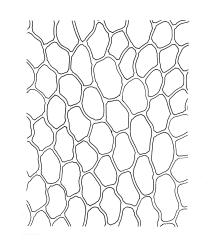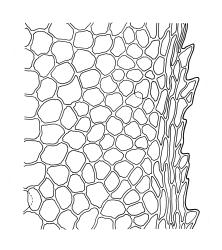- ≡ Leskea cristata Hedw., Sp. Musc. Frond. 211 (1801)
- ≡ Hookeria cristata (Hedw.) Hook. & Grev., Edinburgh J. Sci. 2: 228 (1825)
- ≡ Eriopus cristatus (Hedw.) Brid., Bryol. Univ. 2, 788 (1827)
- = Eriopus jelinekii Müll.Hal. in Reichardt, Reise Novara 1, 185 (1870)
- = Hookeria lophophora Colenso, Trans. & Proc. New Zealand Inst. 17: 260 (1885)
Plants robust, rigid, yellow-, brown-, or grass-green, weakly iridescent, forming loose, often layered turves. Stems erect or ± stoloniferous and then forming layered turves, sparsely to much branched, yellow, becoming brown in older portions, c. 20–100 mm or more, in cross-section with a coloured, subcortical region of firm-walled cells, central strand weak or lacking, c. 700 µm diam., with scattered golden-brown, smooth rhizoids arising at leaf bases. Shoots mostly 5–8 mm wide. Leaves inserted in 6 or 8 ranks, widely spaced below, becoming larger and closely overlapping above, strongly crisped when dry, those in dorsal and ventral ranks ± symmetric, broadly elliptic to broadly obovate, those in lateral ranks strongly asymmetric, elliptic to broadly obovate, tapered to a broadly acute and weakly apiculate apex, plane at margins, bordered, spiculose-spinose from about mid leaf, 3–6 mm × 2–3 mm (ventral and dorsal leaves smaller); upper laminal cells thin- to firm-walled, moderately thickened in corners, (45–)65–100 × 42–60 µm, becoming gradually longer and laxer towards base; marginal cells elongate, thick-walled and porose, forming a ± yellow border 3–5 cells and c. 36–45 µm wide at mid leaf, and fading towards apex. Costa 150–210 µm wide near base, bifurcating 150–600 µm above base, the longer half extending ¼ to ½ the leaf.
Dioicous. Perichaetia lateral, usually aggregated; perichaetial leaves acuminate from an ovate to obovate base, ecostate, unbordered, c. 2.5–3.0 mm (including acumen), often notched at the base of a long filiform acumen. Perigonia ovoid, c. 1 mm long, scattered along ♂ stems, with broadly ovate, obtuse, and ecostate bracts, without paraphyses. Setae 1 per perichaetium, 6–14(–22) mm, straight below, arcuate near apex, stout, (c. 300–350 µm diam.), pale yellow-brown, in cross-section lacking a hyaloderm, densely covered throughout with hyaline, single-celled and non-papillose spines to 165 µm long, with spines becoming abruptly longer (to c. 650 µm) to form a crest immediately below the capsule; capsules pendent, symmetric, 1.7–2.0 mm, smooth when dry, red-brown; operculum conic-rostrate, yellow-brown, c. 0.7 mm long. Exostome teeth as per genus, 360–600 µm; endostome with segments shorter than the teeth; cilia usually absent or rudimentary, sometimes well-developed (to 135 µm long). Calyptra c. 2 mm, covered with hyaline spines above, strongly fimbriate at base. Spores 12–19 µm, smooth.
Hedwig 1801, tab. 49 (as Leskea); Brotherus 1925, fig. 599 (as Eriopus); Sainsbury 1955, pl. 64, fig. 1 (as Eriopus); Beever et al. 1992, fig. 67; Malcolm & Malcolm 2003, p. 11.
When well-developed and fruiting C. cristata is arguably one of the most attractive and most distinctive mosses in the N.Z. flora. It is generally a more robust plant than the equally elegant C. flexicollis. The shoots in the present species are broader (to 8.0 mm vs 4.0 mm) and longer (usually ≥25 mm) than the more delicate C. flexicollis. The leaf apices of C. cristata are broadly acute and only weakly apiculate vs the long-apiculate leaf apices of C. flexicollis. The broader upper laminal cells, the coarser and less spinose marginal teeth, and the better developed costae also set C. cristata apart from the more widely distributed C. flexicollis. In the opinion of R.D. Seppelt (pers. comm. Oct. 2016) the possibility that C. cristata could be a polyploid taxon derived from C. flexicollis could merit investigation.
Sporophyte characters will immediately set it apart from any leafy hepatic, but in the absence of capsules C. cristata could possibly be confused with robust hepatics such as some species of Schistochila.
NI: N Auckland including offshore islands (TK, LB, GB), S Auckland, Gisborne (Cape Runaway, Raukūmara Range, Ruakituri Valley), Hawke’s Bay, Taranaki, Wellington; SI: Nelson, Marlborough, Canterbury (Banks Peninsula), Westland, Southland; St.
Endemic.
Occurring in a range of forest types, but avoiding drier regions. Most often on rock in moist situations, often at the margins of streams, in seepages, and sometimes submerged in running water. Also occurring on rotten logs and on soil. Ranging from near sea level to c. 790 m (Tararua Range, Wellington L.D.) on the North I, and from near sea level (Fox River, Nelson L.D. and other localities) to at least 450 m (Croesus Track, Westland L.D.) on the South I. There are relatively few collections from Taranaki, Marlborough and Canterbury L.D. The paucity of Taranaki records is almost certainly a collection artefact, but the paucity of collections from Marlborough and Canterbury reflects an avoidance of drier habitats.
The only published extra-N.Z. record found is that for a "solitary barren stem" from the magellanic Hermite I. cited by Wilson & Hooker (1847, p. 422). The material forming the basis of this record could not be located in the Wilson herbarium. There is a confusing record for this species in Index Muscorum (Wijk et al. 1962, p. 231) citing this species from several geographic regions. No credence is given here to these records, and C. cristata is best considered a N.Z. endemic; Matteri (1975, p. 692) reached an identical conclusion.
Wilson & Hooker (1854, p. 125) described a var. β based on W. Colenso 404 from Waikare (probably Gisborne L.D.). Material in herb. Wilson (BM) falls within the range of continuous variation of C. cristata and this variety is not worthy of recognition.



